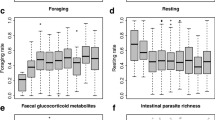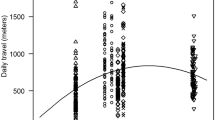Researchers consider group size in primates to be determined by complex relationships among numerous ecological forces. Antipredator benefits and better resource defense are the primary pressures for large groups. Conversely, intragroup limited food availability, can result in greater intragroup feeding competition and individual energy expenditure in larger groups, creating energetic advantages for individuals in small groups and placing an upper limit group size. However, the extent to which food availability constrains group size remains unclear for many species, including black howlers (Alouatta pigra), which ubiquitously live in small social groups (≤10 individuals). We studied the relationship between group size and 2 key indices of feeding competition—day journey length and activity budgets—in 3 groups of wild Alouatta pigra at a hurricane-damaged site in Belize, Central America. We controlled for differences in food availability between home ranges (food tree density) and compared both indicators of feeding competition directly with temporal variation in food availability for each group. Our results show no consistent association between resource availability, group size, and either index of competition, indicating that feeding competition does not limit group size at the site—i.e., that larger groups can form without increased costs of feeding competition. The results support the search for other explanations, possibly social ones, for small group size in the primates, and we conclude with suggestions and evidence for such alternative explanations.


Similar content being viewed by others
REFERENCES
Arrowood, H. C., Treves, A., and Mathews, N. E. (2003). Determinants of day-range length in the black howler monkey at Lamanai, Belize. J. Trop. Ecol. 19: 591–594.
Behie, A. M., and Pavelka, M. S. M. (2005). The short-term effects of a hurricane on the diet and activity of black howlers (Alouatta pigra) in Monkey River, Belize. Folia Primatol. 835: 1–9.
Brockett, R. C., Horwich, R. H., and Jones, C. B. (1999). Disappearance of infants following male takeovers in the Belizean black howler monkey (Alouatta pigra). Neotrop. Prim. 7: 86–88.
Caraco, T., and Wolf, L. L. (1975). Ecological determinants of group sizes of foraging lions. Am. Nat. 109: 343–352.
Chapman, C. A., Wrangham, R. W., and Chapman, L. J. (1995). Ecological constraints on group size: An analysis of spider monkey and chimpanzee subgroups. Behav. Ecol. Sociobiol. 36: 59–70.
Chapman, C. A., and Chapman, L. J. (2000a). Determinants of group size in primates: The importance of travel costs. In Boinski, S., and Garber, P. A. (eds.), On the Move: How and Why Animals Travel in Groups. The University of Chicago Press, Chicago, pp. 24–42.
Chapman, C. A., and Chapman, L. J. (2000b). Constraints on group size in red colobus and red-tailed guenons: Examining the generality of the ecological constraints model. Int. J. Primatol. 21(4): 565–585.
Chapman, C. A., and Balcomb, S. R. (1998). Population characteristics of howlers: Ecological conditions or group history. Int. J. Primatol. 19(3): 385–403.
Chapman, C. A., and Pavelka, M. S. M. (2005). Group size in folivorous primates: Ecological constraints and the possible influence of social factors. Primates 46(1): 1–9.
Cheney, D. L., and Wrangham, R. W. (1987). Predation. In Smuts, B. B., Cheney, D. L., Seyfarth, R. M., Wrangham, R. W., and Struhsaker, T. T. (eds.), Primate Societies. The University of Chicago Press, Chicago, pp. 227–239.
Chinchilla, F. A. (1997). La dieta del jaguar (Panthera onca), el puma (Felis concolor), y el manifordo (Felis pardalis) (Carnivora: Felidae) en el Parque Nacional Corcovado, Costa Rica. Rev. Biol. Trop. 45: 1223–1229.
Clarke, M. R., Zucker, E. L., and Scott, N. U., Jr. (1986). Population trends of the mantled howler groups of La Pacifica, Guanacaste, Costa Rica. Am. J. Primatol. 11: 79–88.
Clarke, M. R., Collins, D. A., and Zucker, E. L. (2002). Responses to deforestation in a group of mantled howlers (Alouatta palliata) in Costa Rica. Int. J. Primatol. 23: 365–381.
Clutton-Brock, T. H., and Harvey, P. H. (1977). Primate ecology and social organization. J. Zool. 183: 1–39.
Cornick, L. A., and Markowitz, H. (2002). Diurnal vocal patterns of the black howler monkey (Alouatta pigra) at Lamanai, Belize. J. Mamal. 83(1): 159–166.
Cowlishaw, G. (1994). Vulnerability to predation in baboon populations. Behaviour 131: 293–304.
Crockett, C. M. (2003). Re-evaluating the sexual selection hypothesis for infanticide by Alouatta males. In Jones, C. B. (ed.), Sexual Selection and Reproductive Competition in Primates: New Perspectives and Directions. The American Society of Primatologists, Norman, pp. 327–365.
Crockett, C. M., and Eisenberg, J. F. (1987). Howlers: Variation in group size and demography. In Smuts, B. B., Cheney, D. L., Seyfarth, R. M., Wrangham, R. W., and Struhsaker, T. T. (eds.), Primate Societies. The University of Chicago Press, Chicago, pp. 54–68.
Crockett, C. M., and Janson, C. H. (2000). Infanticide in red howlers: Female group size, male membership, and a possible link to folivory. In Van Schaik, C. P., and Janson, C. H. (eds.), Infanticide by Males and Its Implications. Cambridge University Press, Cambridge, UK, pp. 75–98.
Di Fiore, A. (2002). Predator sensitive foraging in ateline primates. In Miller, L. E. (ed.), Eat or be eaten: Predator sensitive foraging among primates. Cambridge University Press, Cambridge, UK, pp. 242–267.
Dunbar, R. I. M. (1988). Primate Social Systems. Croom Helm, London.
Estrada, A., Castellanos, L., Garia, Y., Franco, B., Munoz, D., Ibarra, A., Rivera, A., Fuentes, E., and Jimenez, C. (2002). Survey of the black howler monkey, Alouatta pigra, population at the Mayan site of Palenque, Chiapas, Mexico. Primates 43(1): 51–58.
Gillespie, T. R., and Chapman, C. A. (2001). Determinants of group size in the red colobus monkey (Procolobus badius): An evaluation of the generality of the ecological-constraints model. Behav. Ecol. Sociobiol. 50: 329–338.
Gonzalez-Kirchner, J. P. (1998). Group size and population density of the black howler monkey (Alouatta pigra) in Muchukux Forest, Quintana Roo, Mexico. Folia Primatol. 69: 260–265.
Hamilton, W. D. (1971). Geometry for the selfish herd. J. Theor. Biol. 31: 295–311.
Horwich, R. H., and Gebhard, K. (1983). Roaring rhythms in black howler monkeys (Alouatta pigra) of Belize. Primates 24: 290–296.
Horwich, R. H., and Johnson, E. D. (1986). Geographical distribution of the black howler (Alouatta pigra) in Central America. Primates 27: 53–62.
Horwich, R. H., Brockett, R. C., James, R. A., and Jones, C. B. (2001). Population structure and group productivity of the Belizean black howling monkey (Alouatta pigra): Implications for female socioecology. Prim. Rep. 61: 47–65.
Janson, C. H. (1988). Food competition in brown capuchin monkeys (Cebus apella): Quantitative effects of group size and tree productivity. Behaviour 105: 53–76.
Janson, C. H., and Goldsmith, M. L. (1995). Predicting group size in primates: Foraging costs and predation risks. Behav. Ecol. 6: 326–336.
Knopff, K. H., Knopff, A. R. A., and Pavelka, M. S. M. (2004). Observed case of infanticide committed by a resident male Central American black howler monkey (Alouatta pigra). Am. J. Primatol. 63(4): 239–244.
Koenig, A., and Borries, C. (2002). Feeding competition and infanticide constrain group size in wild hanuman langurs. Am. J. Primatol. 57(Suppl. 1): 33–34.
Lehmann, J., and Boesch, C. (2004). To fission or to fusion: effects of community size on wild chimpanzee (Pan troglodytes verus) social organization. Behav. Ecol. Sociobiol. 56: 207–216.
Ostro, L. E. T., Silver, S. C., Koontz, F. W., Young, T. P., and Horwich, R. H. (1999a). Ranging behavior of translocated and established groups of black howler monkeys Alouatta pigra in Belize, Central America. Biol. Cons. 87: 181–190.
Ostro, L. E. T., Young, T. P., Silver, S. C., and Koontz, F. W. (1999b). A geographic information system method for estimating home range size. J. Wildl. Manage. 63: 748–755.
Ostro, L. E. T., Silver, S. C., Koontz, F. W., Horwich, R. H., and Brockett, R. (2001). Shifts in social structure of black howler (Alouatta pigra) groups associated with natural and experimental variation in population density. Int. J. Primatol. 22: 733–748.
Palacios, E., and Rodriguez, A. (2001). Ranging pattern and use of space in a group of red howler monkeys (Alouatta seniculus) in a southeastern Colombian rainforest. Am. J. Primatol. 55: 233–251.
Pavelka, M. S. M., and Knopff, K. H. (2004). Diet and activity in black howler monkeys (Alouatta pigra) in southern Belize: Does degree of frugivory influence activity level? Primates 45: 105–111.
Pavelka, M. S. M. (2003). Group, range, and population size in Alouatta pigra at Monkey River, Belize. Neotrop. Prim. 11: 187–191.
Pavelka, M. S. M., Brusselers, O., Nowak, D., and Behie, A. M. (2003). Population reduction and social disorganization in A. pigra following a hurricane. Int. J. Primatol. 24: 1037–1055.
Pavelka, M. S. M., and Behie, A. M (2005). The effect of hurricane Iris on the food supply of black howlers (Alouatta pigra) in Southern Belize. Biotropica 37(1): 102–108.
Pavelka, M. S. M., and Chapman C. A. (2006). Population responses of Alouatta pigra to hurricane Iris: Possible causes for decline. In Estrada, A. E., Garber, P., Pavelka, M. S. M., and Lueke, L. (eds.), New Perspectives in the Study of MesoAmerican Primates: Distribution, Ecology, Behavior, and Conservation. Springer, New York, pp. 143–163.
Peetz, A., Norconk, M. A., and Kinzey, W. G. (1992). Predation by jaguar on howler monkeys (Alouatta seniculus) in Venezuela. Am. J. Primatol. 28: 223–228.
Peres, C. A. (1990). A harpy eagle successfully captures an adult male red howler monkey. Wilson Bull. 102: 560–561.
Peres, C. A. (1994). Primate responses to phenological changes in an Amazonian terra firme forest. Biotropica 26: 98–112.
Schlichte, H. J. (1978). A preliminary report on the habitat utilization of a group of howler monkeys (Alouatta villosa pigra) in the national park of Tikal, Guatemala. In Montgomery, G. G. (ed.), The Ecology of Arboreal Folivores. Smithsonian Institution Press, Washington, DC, pp. 551–556.
Silver, S. C., Ostro, L. E. T., Yeager, C. P., and Horwich, R. (1998). Feeding ecology of the black howler monkey (Alouatta pigra) in Northern Belize. Am. J. Primatol. 45: 263–279.
Smith, J. D. (1970). The systematic status of the black howler monkey, Alouatta pigra lawrence. J. Mammal. 51: 358–369.
Steenbeek, R., and van Schaik, C. P. (2001). Competition and group size in Thomas’s langurs (Presbytis thomasi): The folivore paradox revisited. Behav. Ecol. Sociobiol. 49: 100–110.
Terborgh, J., and Janson, C. H. (1986). The socioecology of primate groups. Annu. Rev. Ecol. Syst. 17: 111–135.
Treves, A., Drescher, A., and Ingrisano, N. (2001). Vigilance and aggregation in black howler monkeys (Alouatta pigra). Behav. Ecol. Sociobiol. 50: 90–95.
van Schaik, C. P. (1989). The ecology of social relationships among female primates. In Standen, V., and Foley, R. A. (eds.), Comparative Socioecology: The Behavioral Ecology of Humans and Other Animals. Blackwell, Boston, pp. 195–218.
Wrangham, R. W. (1980). An ecological model of female-bonded primate groups. Behaviour 75: 262–300.
Wrangham, R. W., Gittleman, J. L., and Chapman, C. A. (1993). Constraints on group size in primates and carnivores: Population density and day-range as assays of exploitation competition. Behav. Ecol. Sociobiol. 32: 199–209.
ACKNOWLEDGMENTS
The Monkey River Village Council, The Forestry Department of the Government of Belize, and the Toledo Institute for Development and the Environment granted permission to conduct research in Belize. The Life and Environmental Sciences Animal Care Committee of the University of Calgary approved the research, in accordance with the principles of the Canadian Council on Animal Care (BI2003-023). In addition, we acknowledge continued local support for the project by the people of Monkey River. We thank Aliah Knopff, Keriann McGoogan, and Travis Steffens for field assistance; Tracy Wyman for help with GIS data; and Colin Chapman for feedback on the original manuscript. Two anonymous reviewers provided valuable comments. We also greatly appreciate financial support provided by the Department of Anthropology, the Faculty of Social Sciences, and Research Services at the University of Calgary, the Natural Science and Engineering Research Council of Canada (NSERC), and The National Geographic Society.
Author information
Authors and Affiliations
Corresponding author
Rights and permissions
About this article
Cite this article
Knopff, K.H., Pavelka, M.S.M. Feeding Competition and Group Size in Alouatta pigra . Int J Primatol 27, 1059–1078 (2006). https://doi.org/10.1007/s10764-006-9060-1
Received:
Accepted:
Published:
Issue Date:
DOI: https://doi.org/10.1007/s10764-006-9060-1




